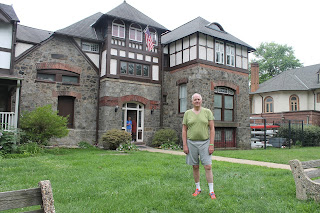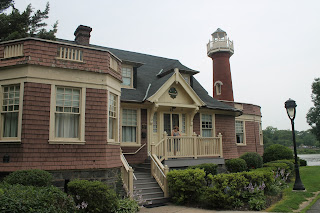Who designed Philadelphia?
The City of Philadelphia was founded by William Penn, on a chart given to him by Charles II, the King of England, as a form of settlement of debts that the Crown had with Penn's father, Admiral Penn. The King allotted Penn the entire state, and gave it the name of Pennsylvania, together with the land which now we know as the state of Delaware. The name of Pennsylvania means Forest of Penn.
View of the Schuylkill River from the
Phialdelphia Water Works
There were already white settlers there, among them, several Swedes. But Penn gave Philadelphia, from the start, a great deal of his own ideals and personality.
For years, I have told my friends in Mexico, when they asked me what is Philadelphia like, that the city has a very English look about it. The brick houses, stone steps leading up to the front door, the white wooden frames around the doorways and the window shutters. One day my wife asked me, "Why don't you find London fascinating?", and I answered "London looks too much like the city where I grew up: there is nothing exotic about it, nothing out of the ordinary!"
View of the dam on the Schuylkill River
The railing is supported on a Palladian Balaustrade
The fact is, the similarity between the architectural style of Philadelphia and London is a half-truth. Even Penn expressed his desire to built a better city than London, avoiding several shortcomings of the capital of England. One thing he wanted was straight streets, square standard-sized city blocks, and parks, within easy walking distance.
Architecture in Philadelphia has gone through five distinct stages:
- a Colonial and Federal Period, roughly from 1700 until 1795,
- a Classical Period, from 1800 until 1830, followed by
- a Victorian Period, from 1830 until 1900, followed by
- the Beautiful City period, from 1900 until the Great Depression,
- followed by a Modern Skyscraper Period of tall buildings of glass and steel, forming a modern city skyline, similar to that of many other American metropolis in the late XX Century and early XXIst Century. This period started in 1987, when the city permitted a building higher than the statue of William Penn on top of City Hall.
The buildings in Philadelphia built in the 18th and 19th century and are still existing, not only portray an "English style", but more precisely a neoclassical style, which we can find here and in Virginia, e.g. Montebello, and in Washington.
Typical Palladio-style Rotonda
at the Philadelphia Water Works
I lived the first 18 years of my life in Philadelphia, and I never realized how strong was the influence of Italianate Renaissance style prevalent in its many mansions, buildings, churches and houses. Yet when I went to study to live and study in the 1960's to Rome, I felt a familiar feeling in the architecture. Almost every year, I go back to Italy, and only a few months ago I was in the Veneto region, visiting several villas built by Palladio in the 16th Century. Again I felt that strange feeling of familiarity with those buildings.
View of the Philadelphia Water Works
Philadelphia Museum of Art in background
Modern Philadelphia Skyline in back.
Last week, my wife and I visited the Philadelphia Water Works, built on the Schuylkill River at the beginning of the 19th Century. All at once, I realized that the design was completely Palladio.
Frederick Graff (1774-1847) was the architect of the Fairmount Water Works of Philadelphia. Frederick Graff was obviously influenced, as many of his contemporaries, by the leading architect of Philadelphia at the beginning of the 19th century, Benjamin Henry Latrobe (1764-1820).
Underground tunnel
Fairmont Water Works
Latrobe was the architect of the First Bank of Pennsylvania, and was the lifelong friend and mentor of Graff. Latrobe studied in England, where the prevailing style in public buildings and works, such as bridges, was inspired in a revival of the style Andrea Palladio initiated in the 16th Century. Graff possibly used a design for the Fairmount Water Works that Palladio had developed for a bridge.
Bridge designed by Andrea Palladio in Bassano
Graff and Latrobe were the precursors of the Greek Revival Architecture that is conceived in England and crosses the Atlantic, taking up roots first in Philadelphia, then in Washington. Latrobe had an apprentice in his office, the son of a carpenter: William Strickland (1788-1854). Strickland worked on seven projects, that converted Philadelphia into the Athens of America:
- The Second Bank of the United States,
- The Masonic Hall
- United States Naval Home
- The First Unitarian Church
- The Arch Street Theater
- The US Mint and
- The Merchant Exchange.
Pipelines from Water Works
to Reservoir
200 years ago, Graff's first water mains 200 years ago were made out of hallowed timber. These pipelines carried the water uphill from the water works to reservoir, where now is the Philadelphia Museum of Art. What was the need of a massive Water Works project, precisely at the end of the XVIIIth Century? Pestilence had been the cause of a reduction of 10% of the Population of Philadelphia between 1796 and 1798, and people were wary of the well water.
Machine room in the pump house
Fairmont Water Works
Strickland based his design of the Doric-pillared porticos of the Second Bank on the Parthenon of Athens. that he had studied in a book published in London, between 1762 and 1816, and written by James Stuart and Nicholas Revett: "The Antiquities of Athens". When referring to "the Antiquities", Strickland called it his "bible". But why Doric Columns? Why not Ionic or Corinthian? It was a simple question of money. Doric is more simple, and less expensive.
William Strickland's Second
Bank of the United States
During a toast in his honor, a colleague repeated the boast of Cesar Augustus said of the Rome he was building during his reign: "Strickland found us living here in Philadelphia in a city of bricks, and he leaves us in a city of marble."





















































